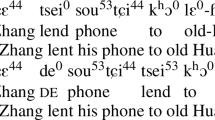Abstract
This paper documents the development of an empirically-basedsystem implemented in Prolog that automatically resolves severalkinds of anaphora in Spanish texts. These are pronominalreferences, surface-count anaphora, one-anaphora and ellipticalzero-subject constructions (i.e., sentences that omit theirpronominal subject). The resolution is based onrepresentations resulting from either partial or full parsing. Thesystem developed can also work on the output of a POStagger or with different dictionaries, without changing thegrammar. This grammar represents the syntactic information of eachlanguage by means of the Slot Unification Grammar formalism. The different kinds of information used for anaphora resolution in full and partial parsing are shown, as wellas evaluation results. The system has been adapted toEnglish texts, obtaining encouraging results that prove that itcan be applied with only a very few refinements to other languagesas well as Spanish and English. In addition, the differencesbetween English and Spanish anaphora are noted.
Similar content being viewed by others
References
Abney, S.: 1997, ‘Part-of-Speech Tagging and Partial Parsing’, in S. Young and G. Bloothooft (eds), Corpus-based Methods in Language and Speech Processing, Dordrecht, Kluwer Academic Publishers, pp.118-136.
Azzam, S.: 1995, ‘An Algorithm to Co-ordinate Anaphora Resolution and PPS Disambiguation Process’, Seventh Conference of the European Chapter of the Association for Computational Linguistics, Dublin, Ireland, 284-285.
Baldwin, B.: 1997, ‘CogNIAC: High Precision Coreference with Limited Knowledge and Linguistic Resources’, Proceedings of the ACL'97/EACL'97 Workshop on Operational Factors in Practical, Robust Anaphora Resolution, Madrid, Spain, pp. 38-45.
Connolly, D., J. D. Burger, and D. S. Day: 1994, ‘A Machine Learning Approach to Anaphoric Reference’, International Conference on New Methods in Language Processing, (NeMLaP), Manchester, England, pp. 255-261.
Ferrández, A., M. Palomar and L. Moreno: 1997a, ‘Slot Unification Grammar’, APPIA-GULP-PRODE '97: Joint Conference on Declarative Programming, Grado, Italy, pp. 523-532.
Ferrández, A., M. Palomar and L. Moreno: 1997b, ‘Slot Unificacion Grammar and Anaphora Resolution’, International Conference Recent Advances in Natural Language Processing, Tzigov Chark, Bulgaria, pp. 294-299.
Ferrández, A., M. Palomar and L. Moreno: 1998a, ‘A Computational Approach to Pronominal Anaphora, One-anaphora and Surface Count Anaphora’, New Approaches to Discourse Anaphora: Proceedings of the Second Colloquium on Discourse Anaphora and Resolution Colloquium (DAARC2), Lancaster, England, pp. 117-128.
Ferrández, A., M. Palomar and L. Moreno: 1998b, ‘Anaphor Resolution in Unrestricted Texts with Partial Parsing’, COLING-ACL '98: 36th Annual Meeting of the Association for Computational Linguistics and 17th International Conference on Computational Linguistics, Montreal, Quebec, pp. 385-391.
Guenthner, F.: 1987, ‘Linguistic Meaning in Discourse Representation Theory’, Synthese 73, 569-598.
Kamp, H.: 1981, ‘A Theory of Truth and Semantic Representation’, in J. Groenedijk, J. Janssen and M. Stokhof (eds), Formal Methods in the Study of Language, Dordrecht, Foris, pp. 277-322.
Kennedy, C. and B. Boguraev: 1996, ‘Anaphora for Everyone: Pronominal Anaphora Resolution without a Parser’, COLING-96: The 16th International Conference on Computational Linguistics, Copenhagen, Denmark, pp. 113-118.
Lappin, S. and H. Leass: 1994, ‘An Algorithm for Pronominal Anaphora Resolution’, Computational Linguistics 20, 535-561.
McCord, M. C.: 1990, ‘Slot Grammar: A System for Simpler Construction of Practical Natural Language Grammars’, in R. Studer (ed.), Natural Language and Logic: International Scientific Symposium, Berlin, Springer Verlag, pp. 118-145.
Mitkov, R.: 1995, ‘An Uncertainty Reasoning Approach to Anaphora Resolution’, Proceedings of the Natural Language Processing Pacific Rim Symposium (NLPRS'95), Seoul, Korea, pp. 149-154
Mitkov, R.: 1996, ‘Pronoun Resolution: The Practical Alternative’, paper presented at the Discourse Anaphora and Resolution Colloquium (DAARC'96), Lancaster, UK, to appear in S. Botley and T. McEnery (eds), Discourse Anaphora and Anaphora Resolution, Amsterdam, John Benjamins.
Mitkov, R.: 1997, ‘Factors in Anaphora Resolution: They are Not the Only Things that Matter. A Case Study Based on Two Different Approaches’, Proceedings of ACL/EACL Workshop on Operational Factors in Practical, Robust Anaphora Resolution, Madrid, Spain, pp. 14-21.
Mitkov, R.: 1998, ‘Robust Pronoun Resolution with Limited Knowledge’, COLING-ACL '98: 36th Annual Meeting of the Association for Computational Linguistics and 17th International Conference on Computational Linguistics, Montreal, Quebec, pp. 869-875.
Mitkov, R. and M. Stys: 1997, ‘Robust Reference Resolution with Limited Knowledge: High Precision Genre-Specific Approach for English and Polish’, International Conference Recent Advances in Natural Language Processing, Tzigov Chark, Bulgaria, pp. 74-81.
Moreno, L, F. Andrés and M. Palomar: 1992, ‘Incorporar restricciones semánticas en el análisis sintáctico: IRSAS [Incorporating semantic restrictions in the syntactic analysis: IRSAS]’, Procesamiento del Lenguaje Natural 11, 75-86.
Moreno, L. and M. Palomar: 1992, ‘Semantic Constraints in a Syntactic Parser: Queries-answering [sic] to Database’, in A. Min Tjoa and I. Ramos (eds), Database and Expert Systems Applications, Berlin, Springer-Verlag, pp. 155-160.
Reinhart, T.: 1983, Anaphora and Semantic Interpretation, Beckenham, Kent, Croom Helm.
Author information
Authors and Affiliations
Rights and permissions
About this article
Cite this article
Ferrández, A., Palomar, M. & Moreno, L. An Empirical Approach to Spanish Anaphora Resolution. Machine Translation 14, 191–216 (1999). https://doi.org/10.1023/A:1011189309486
Issue Date:
DOI: https://doi.org/10.1023/A:1011189309486




